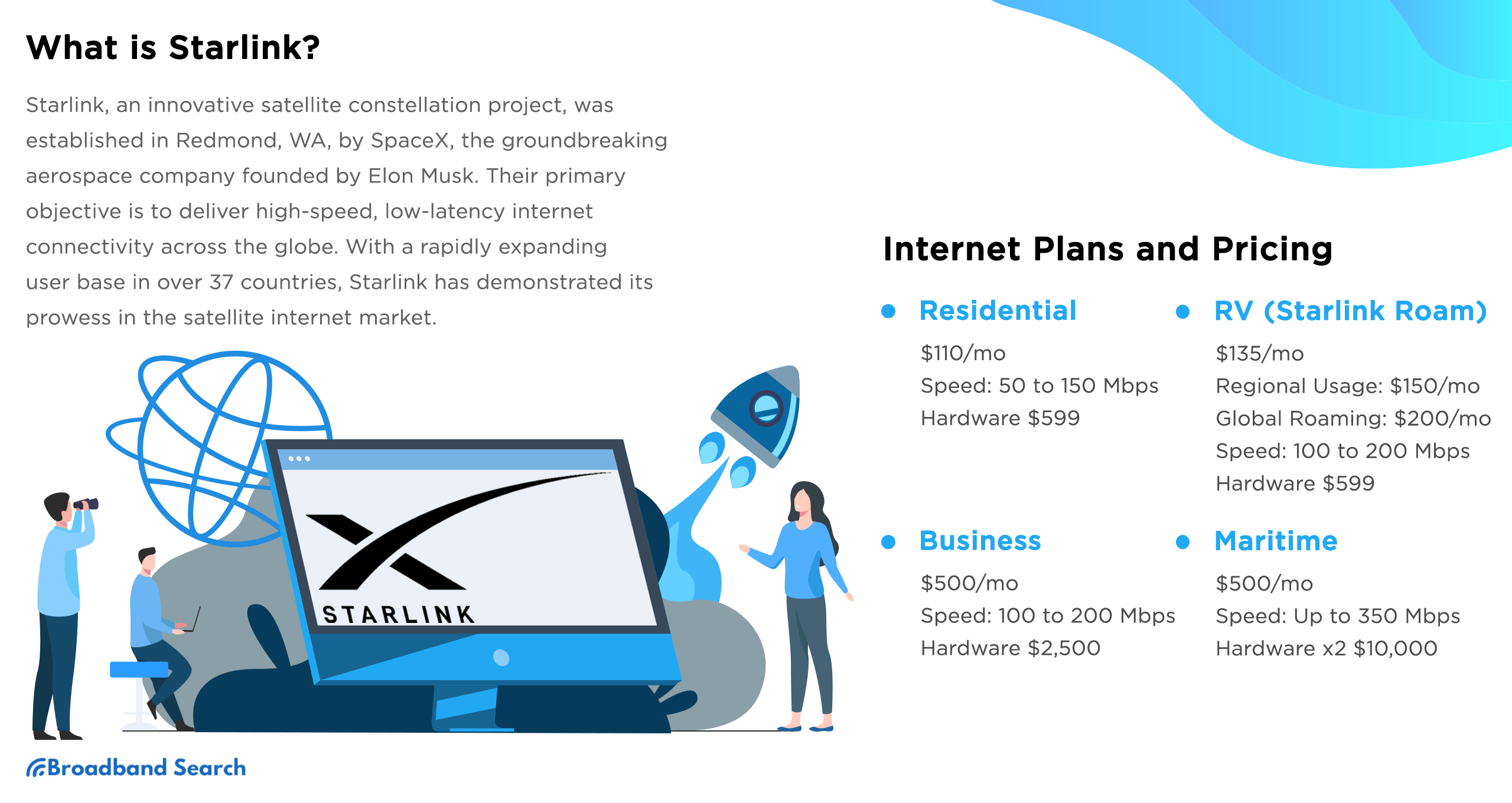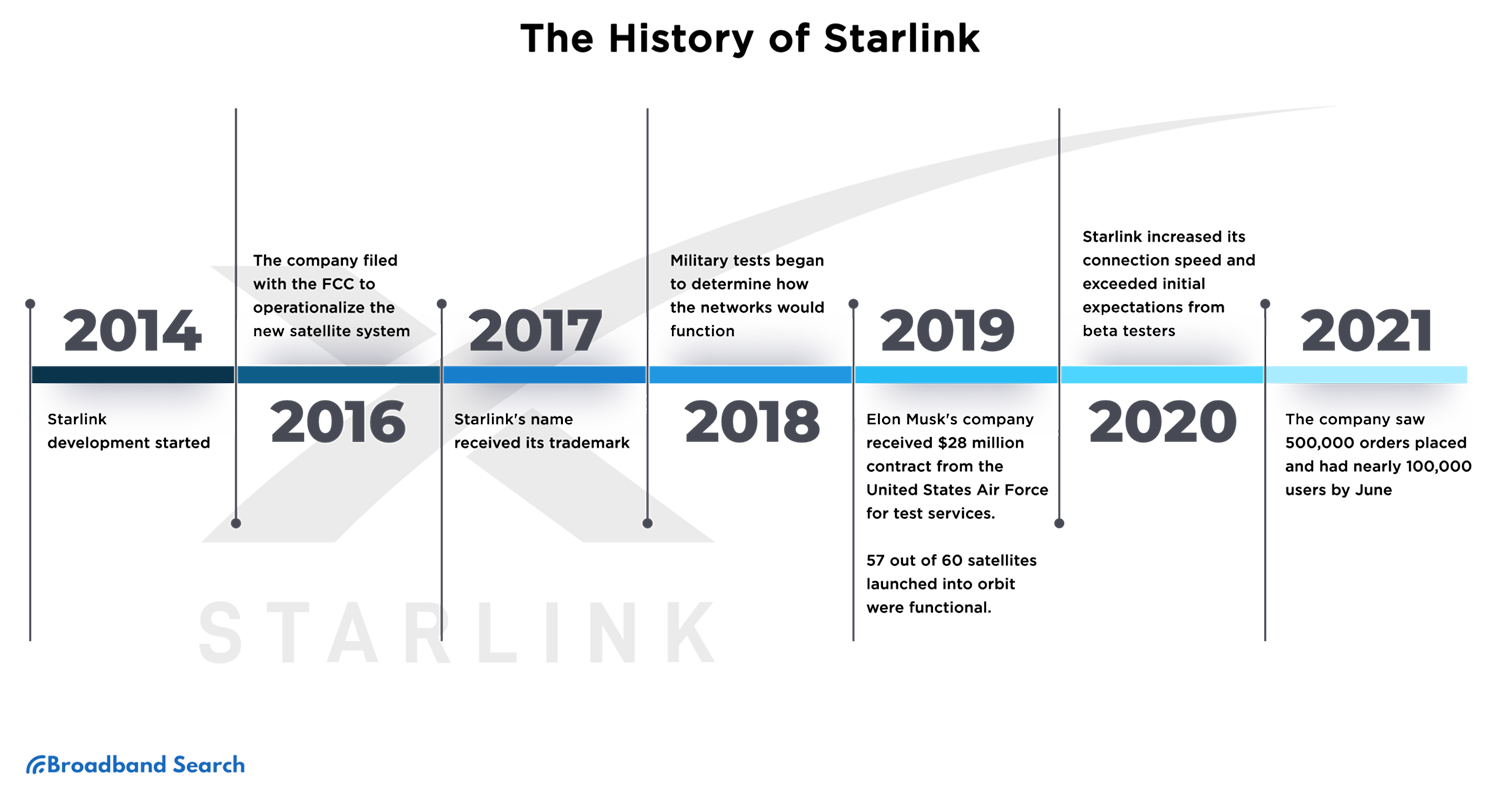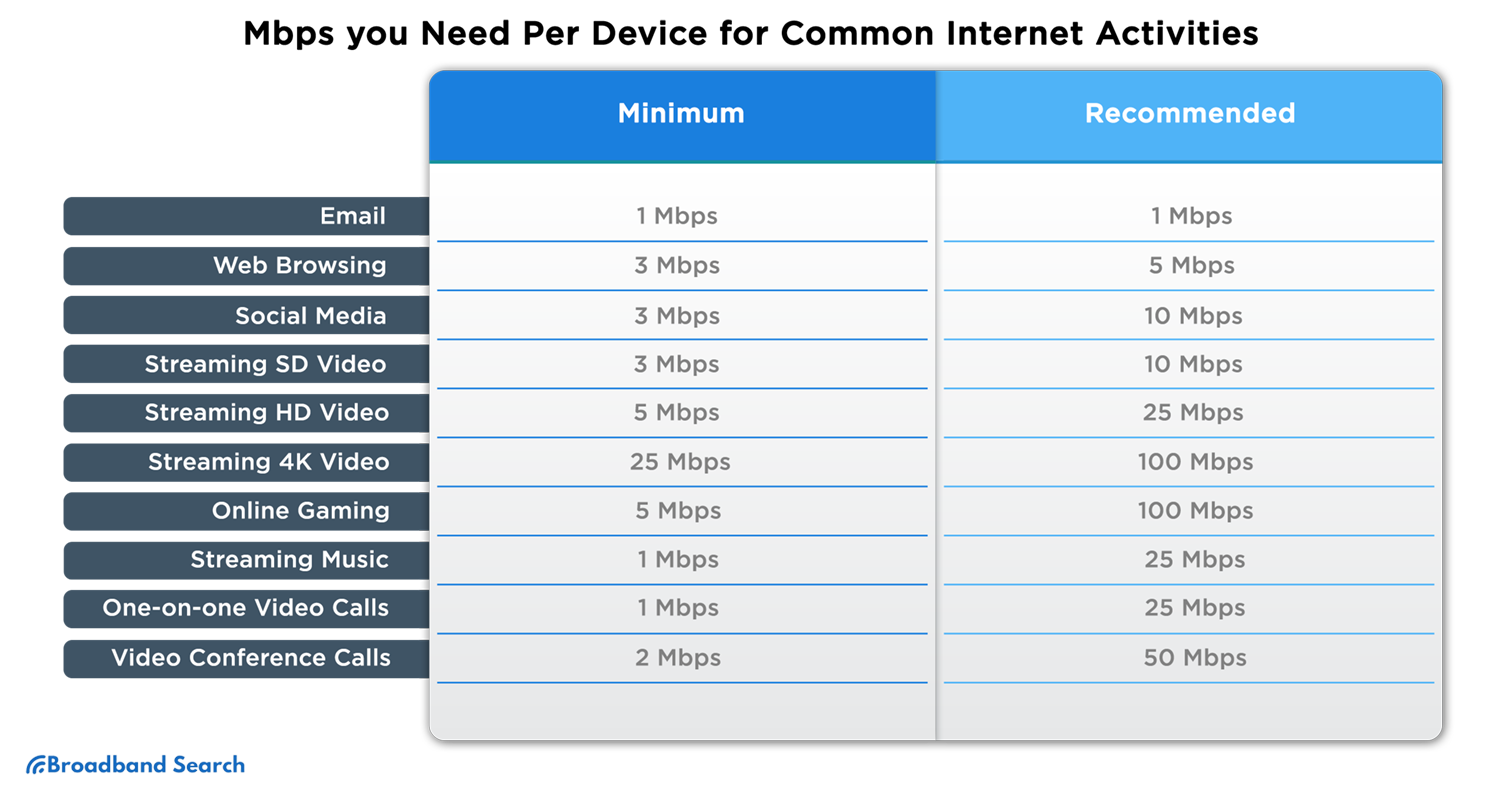According to PC Mag, in 2021, 51% of Americans showed interest in signing up for Starlink's satellite internet, attracted by its promise of high-speed, low-latency service. Of those 51% of Americans:
- 74% want faster internet for streaming
- 72% need it for video calls
- 56% want competitive speeds for online gaming
Starlink's appeal was clear, especially as 55% were willing to pay more for faster speeds. This article explores Starlink’s internet plans, pricing, benefits, and customer service to help you decide if it’s the right choice for your needs.
What is Starlink?
Starlink, an innovative satellite constellation project, was established in Redmond, WA, by SpaceX, the groundbreaking aerospace company founded by Elon Musk. Its primary objective is to deliver high-speed, low-latency internet connectivity around the globe, and it has already made significant strides in achieving this goal. With a rapidly expanding user base in over 37 countries, Starlink has demonstrated its prowess in the satellite internet market.
The Starlink Satellite Constellation
Starlink operates through a network of Low-Earth Orbit (LEO) satellites positioned approximately 550 km (~341 mi) above Earth — dramatically closer than traditional geostationary (GEO) satellites that orbit at about 35,000 km (~22,000 mi). This proximity delivers significant advantages, including lower latency (typically 20-40 ms compared to 600+ ms for GEO satellites) and faster signal relay.
The scale of Starlink's constellation is impressive. SpaceX has launched over 5,000 satellites with thousands more planned for deployment. Between October 2021 and April 2023 alone, SpaceX launched 1,919 Starlink satellites—an 185% increase in their internet satellite count. This growth demonstrates its dedication to expanding services to a broader audience.
Network Infrastructure
Starlink's advanced technology sets it apart from traditional satellite internet:
- Inter-Satellite Laser Links: Starlink satellites communicate directly with each other through laser links, reducing reliance on ground stations and improving global coverage efficiency.
- Ground Stations: These facilities connect the satellite constellation to the broader internet backbone, ensuring seamless integration with existing infrastructure.
- User Terminals ("Dishy"): The customer equipment features phased-array antennas that automatically track moving satellites. Newer portable models like "Starlink Mini" offer additional flexibility for mobile users.
Performance Characteristics
Starlink delivers performance that rivals traditional broadband in many areas:
- Latency: Typically 20-50 ms, comparable to fiber and cable connections
- Speeds: 50-250 Mbps for residential users, with higher tiers available for business and maritime applications
- Coverage: Expanding globally with a focus on underserved rural and remote communities
Target Users and Market Goals
Starlink focuses on approximately 60 million rural and remote U.S. residents with limited internet options. It also serves mobile users, including RV travelers, maritime vessels, and aviation. Starlink’s strategic global expansion targets regions where fiber or cable infrastructure is impractical or unavailable.
| Starlink Plan | Price | Speed | Data | Equipment | Best for | Extras |
|---|---|---|---|---|---|---|
| Starlink Residential | $120/mo or $80/mo for Residential Lite | 50-150 Mbps | Unlimited | $175 + tax (dish, tripod, Wi-Fi router) | Households in rural/remote areas | Unlimited Data, Fixed Location |
| Starlink Roam | $165/mo (unlimited) or $50/mo (50 GB) | 50-500 Mbps (location dependent) | 50 GB — unlimited | $175-499 + tax (portable dish + mounting gear) | Travelers, campers, nomads | Easy setup, app-assisted positioning, portable gear |
| Starlink Business (Local Priority) | $65-500/mo | 100-200 Mbps | 50 GB – 2 TB | $999 + $50 + tax | Small businesses, offices, high-demand users on land | Single Country Land Use and Regional Travel, Network Priority, Reliable Fixed & In-motion Use, Public IP & Dashboard |
| Starlink Business (Global Priority) | $250-$2,150/mo | 100-350 Mbps | 50 GB – 2 TB | $1,999 + $50 + tax | International enterprises, ships and vessels requiring reliable offshore internet | Ocean & Global Land Use, Network Priority, Reliable Fixed & In-motion Use, Public IP & Dashboard |
Internet Plans, Pricing, and Equipment
Starlink offers a diverse range of packages to cater to various user requirements:
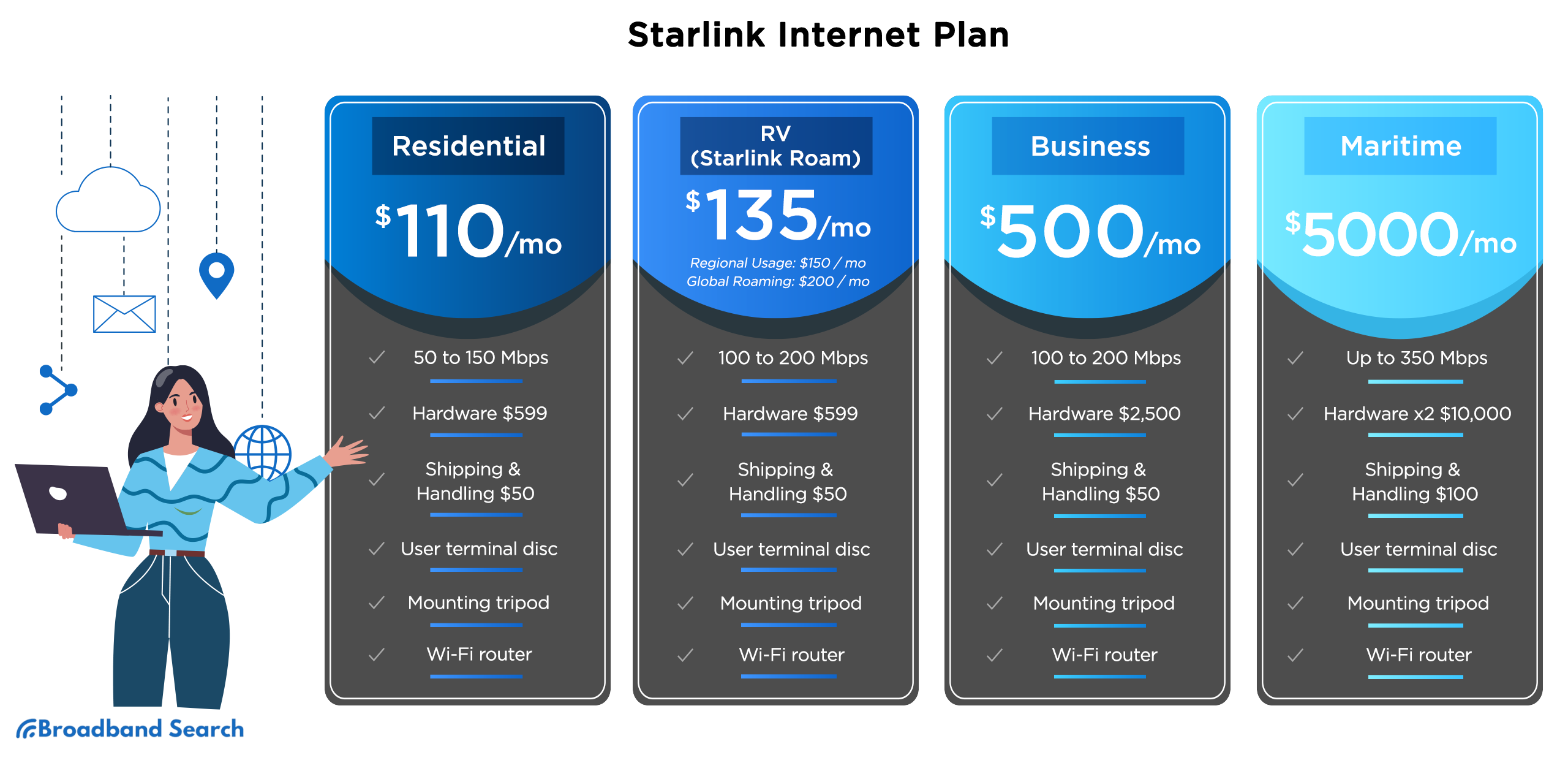
Starlink Residential
- Price: $110 per month
- Internet Speed: 50 to 150 Mbps
- Equipment Cost: $599 + $50 shipping and handling fee
Starlink Residential plan offers a reliable internet connection to users in rural and remote areas who previously had limited options for high-speed internet access. This plan is ideal for streaming, gaming, and general browsing, it caters to a variety of household needs. The one-time equipment fee covers the user terminal disc, mounting tripod, and Wi-Fi router. In addition to the speed range and pricing, this plan offers low latency (typically between 20-40ms) for an enhanced online experience.
Starlink RV (Starlink Roam)
- Price: $150-$200 per month
- Internet Speed: 50 to 500 Mbps
- Equipment Cost: $599 + $50 shipping and handling fee
Available in two versions—regional usage at $150 per month and global roaming at $200 per month. The service is designed for users on-the-go or living in campers, offering varying speeds depending on the location.
The regional usage version focuses on providing reliable coverage within a specific area, while the global roaming option ensures connectivity even in the most remote locations. With a quick setup process and portable equipment, the Starlink Roam is perfect for adventurers and nomads alike.
The equipment included in the Starlink RV plan is a portable dish and mounting equipment. These components are lightweight and designed to be easily transportable, making them ideal for mobile vehicles and nomads. The portable dish receives signals from Starlink's satellites, converting them into a Wi-Fi signal that can be used to establish a wireless internet connection wherever the user travels. The mounting equipment provides stability for the portable dish and allows for easy setup and installation. Users can also use the starlink mobile app in finding the best location for the dish to ensure maximum signal strength.
Starlink Business
- Price: $500 per month
- Internet Speed: 100 to 200 Mbps
- Equipment Cost: $2,500 + $50 shipping and handling fee
Targeting small offices, storefronts, and high-demand users, this plan provides dedicated customer support and priority access to network upgrades, ensuring a seamless experience for businesses. The higher speeds and lower latency contribute to improved productivity and collaboration, catering to professional environments.
The Starlink Business plan also includes equipment consisting of a user terminal disc, a mounting tripod, and a Wi-Fi router. These components are similar to those included in the Starlink Residential plan, but the service is targeted at small offices, storefronts, and high-demand users.
The hardware for this plan is also scalable, allowing businesses to add additional components as needed to meet growing demand. The plan also includes enhanced security features, making it ideal for businesses that handle sensitive data.
Starlink Maritime
- Price: $5,000 per month
- Internet Speed: 100 to 350 Mbps
- Equipment Cost: $10,000 + $100 shipping and handling fee
Specifically designed for vessels, the Maritime plan includes 24/7 dedicated customer support for maintaining internet connections in extreme weather conditions. Unlike other Starlink plans, all components including the mounting tripods and Wi-Fi routers are engineered to withstand the challenging maritime environment.
The two user terminal discs provide redundancy and ensure a stable connection, even in rough seas or other challenging conditions. The mounting tripods provide stability for the discs, and the Wi-Fi routers allow for multiple devices to connect to the internet.The plan also integrates with shipboard systems and IoT applications, providing a comprehensive connectivity solution for maritime users.
Starlink's edge is its use of low orbiting satellites, setting it apart from traditional providers. Most satellite internet relies on a single geostationary satellite at 35,786 km, resulting in high latency. In contrast, Starlink's thousands of satellites orbit much closer to Earth at around 550 km, providing global coverage with reduced latency (around 25ms compared to 600+ ms). This advantage allows for seamless streaming, online gaming, video calls, and high data rate activities even in rural and remote areas.
Contracts, Data Caps, and Bundle Options
Starlink sets itself apart from other internet service providers by providing a customer-centric approach, offering their users added flexibility with their internet plans.
Contracts
Starlink has a no-contract policy, so you can cancel anytime without fees or penalties. Moreover, Starlink offers a 30-day refund policy for its equipment. Keep in mind that Starlink doesn't prorate their service, so if you choose to cancel mid-month, you'll still have access until the end of your billing cycle.
Data Caps
Starlink's Fair Use Policy provides residential customers with a generous 1TB of high-speed data every month. Should you exceed the 1TB cap, you'll need to pay $0.25 per GB to maintain high-speed data access. Otherwise, SpaceX may reduce your broadband quality to manage network traffic.
It's worth noting that business users face stricter terms, with data speeds dropping to 1 Mbps for uploads and downloads once the cap is reached, and a higher fee of $1 per GB to keep using top-tier Starlink speeds.
Bundle Options
Starlink focuses on delivering excellent internet services without bundle options, which may deter those seeking TV or phone bundles. But Starlink’s internet speeds and low latency are ideal for online streaming platforms like YouTube TV or Hulu + Live TV. Although Starlink doesn't offer phone services, its low latency internet supports Wi-Fi calling, making calls possible in areas with limited cellular coverage.
Starlink's Technology Compared to Other Satellite Providers
Orbit and Latency
- Starlink (LEO ~550 km): Latency of 25-50 ms, much closer to fiber performance
- Traditional GEO Providers (HughesNet, Viasat ~35,000 km): Latency of ~600 ms, unsuitable for gaming and real-time applications
Download Speed
- Starlink: Typically 50-250 Mbps for residential, up to 500 Mbps for business
- GEO Providers: Usually 12-100 Mbps, more prone to network congestion
Coverage and Scalability
- Starlink: Service in 130+ countries, expanding global coverage with thousands of satellites
- GEO Providers: Coverage is limited to the U.S., reliant on a handful of satellites with narrower coverage beams
Overall Comparison
Starlink narrows the gap with fiber and cable in both speed and latency, making it a strong option for rural and underserved areas. Traditional GEO providers remain a reliable fallback where Starlink is unavailable, but they're limited in performance and scalability.
| Provider | Monthly Cost | Download Speed | Upload Speed | Latency | Equipment Cost |
|---|---|---|---|---|---|
| Starlink | Starting at $80 | 50-500 Mbps | 5-30 Mbps | 25-50 ms | $175-$1,999 |
| HughesNet | Starting at $49.99 | 25-100 Mbps | 5 Mbps Max | 683 ms | $9.99-$19.99/mo. to lease; $199.99–$349.99 to purchase |
| Viasat | Starting at $69.99 | 50-150 Mbps | 4 Mbps Max | 600-700 ms | $9.99/mo to lease; $299.99 to purchase |
Where Can You Get Starlink Internet?
While Starlink strives to provide global coverage, it is essential to verify whether your location is within their service area. Initially, Starlink focused on "high latitudes" such as Canada and the northern parts of the United States. However, their coverage has expanded, now encompassing areas closer to the equator as well. In the US, Starlink is available in all 50 states, with a maximum download speed of 350 Mbps.
To sign up, follow these simple steps:
Step 1: Visit Starlink.com and confirm your location is within their service area by entering your address into the SpaceX coverage map.
Step 2: Sign up for the service by providing your physical address and credit card information.
Step 3: Determine whether you can expect your Starlink kit within the standard 2-week window, or if you'll be placed on a waitlist.
Once connected, monthly billing is hassle-free and managed online. Payments are automated, allowing you to "set it and forget it" after the initial sign-up. If you decide to discontinue the service, you can easily cancel through the same web portal without incurring any early termination fees or cancellation penalties.
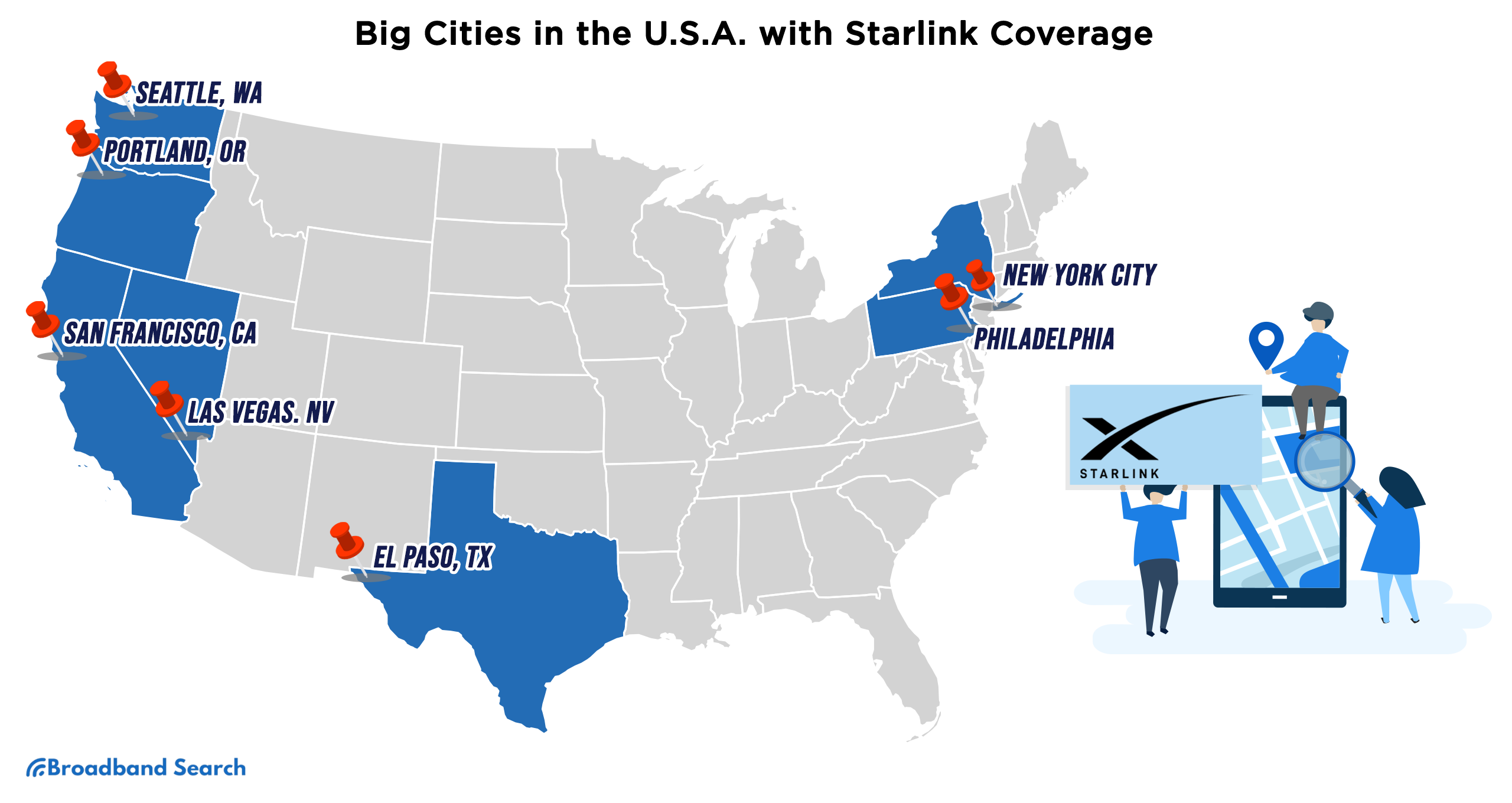
Benefits of Using Starlink Internet
Starlink stands out from traditional internet providers by offering unique benefits to improve the customer experience with innovative solutions.
Easy Setup
Starlink’s simple installation process makes it easy for customers to set up their internet. The Starlink Mobile App, available on iOS and Android, offers features to manage and optimize your connection, including:
- Signal strength indicator
- Installation guide
- Speed test
- Network settings
- Device management
The app ensures users can easily monitor and adjust their internet connection.
Sustainable Satellite Design
Starlink’s satellites are designed with environmental responsibility in mind. When no longer operational, they are programmed to deorbit and burn up in Earth's atmosphere, reducing space debris and keeping space clean for future launches. This highlights Starlink’s commitment to sustainability alongside cutting-edge internet services.
Starlink Customer Service
While Starlink doesn’t offer phone support, its online help center is available 24/7, providing FAQs, troubleshooting guides, and setup instructions. Regular updates on the website and social media keep users informed about outages, maintenance, or other service changes, ensuring a seamless customer experience.
The Bottom Line: Is Starlink Internet Right for You?
Our guide on Starlink Internet covers everything you need to know, from plans and coverage to comparisons with other satellite providers. Starlink offers high speeds and low latency, making it ideal for rural areas and activities like gaming or streaming. However, if you need more flexible plans, alternatives like HughesNet or Viasat may be worth exploring. Choose the option that best fits your needs and budget!
FAQ
How do I contact Starlink internet customer service?
To contact Starlink internet customer service, you can visit their website and click on the "Support" link located at the top of the page. From there, you can browse through their FAQ section and troubleshooting guides, or submit a request for help by clicking the "Contact Support" button at the bottom of the page. You can also contact them by phone, but the phone number is not publicly listed, and only available to Starlink customers.
What happens when a Starlink satellite dies?
When a Starlink satellite dies or fails, it will stop functioning properly and will no longer be able to communicate with ground stations. To prevent any potential collisions or hazards, the satellite will then be moved to a lower orbit where it will eventually burn up upon reentry into the Earth's atmosphere.
Does Starlink use a lot of electricity?
The Starlink user terminal only requires a maximum of 100 watts to function, which is about the same amount of power as a standard light bulb.
Does Starlink internet work with any kind of router?
Starlink works with most standard routers compatible with a wired Ethernet connection. They offer a router to customers, but you can also use your own as long as it supports DHCP and has a WAN port connected to the Starlink user terminal.
Do I need a VPN for Starlink Internet?
No, but while a VPN is not required for Starlink internet, it can be useful for added security and privacy when accessing the internet.

